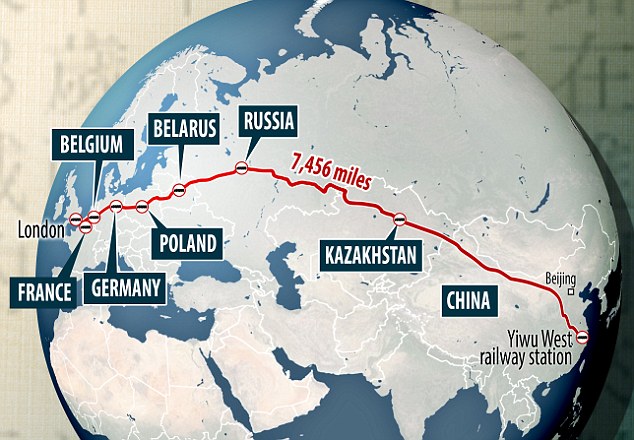The Eurasian Economic Union. About To Bring China To The EU’s Borders

The Eurasian Economic Union was formed on 1st January 2015 and is a trade bloc that currently includes Armenia, Belarus, Kazakhstan, Kyrgyzstan and Russia. Oft cited as “Russia’s answer to the EU”, it remains little understood and has been somewhat ignored by Western businesses. However, while many international companies interact with China, there remains ignorance of the EAEU. That is a mistake as developments within it have the potential to shake up and alter European trade flows between the EU and China and possibly to India and ASEAN as well. The EAEU comes right up to the EU border via Belarus, and its borders with Latvia, Lithuania and most significantly, Poland. All possess huge investment potential as a result of the potential for Chinese involvement with the EAEU.
Collectively the EAEU may appear at first glance to be a miniature recreation of the old Soviet bloc. Such views are misleading. The EAEU has a combined population of 183 million, (about the same size as three United Kingdoms) a GDP (PPP) of over USD4 trillion, and a per capita nominal income of USD13,150, just slightly lower than that of China. If it were a country, in GDP terms it would be the worlds fourth largest economy, just behind Japan but ahead of Germany. The EAEU is also proving something of a success – intra-EAEU trade was up 38% in 2016.
It is for these reasons that numerous countries have applied for Free Trade Agreements with the EAEU. Among them are China, India, Singapore, Iran, and Turkey as part of 40 countries currently involved in FTA negotiations. Of these, the proposed China-EAEU FTA is among the most interesting. While much Western media attention has played on the China “East Wind” trains that have sped from Yiwu through to now 15 European Rail Freight Terminals it has not been recognized that as and when a China-EAEU Free Trade Agreement is reached, Chinese goods will be able to cross the entire Eurasian land mass duty free, and turn up right on the EU’s borders.
This is because the EAEU includes Kazakhstan, Russia and Belarus as members, and is the primary routing for rail freight services to Europe. From there goods are distributed across the European Rail network as far away as Madrid and London. Theoretically, once the goods are in the EU, they can be sent by freight to any railway station within the Union, and beyond.
An agreement between China and the EAEU over Free Trade will have a significant impact on the EU. Goods identified within such an agreement will be primary products for export to the EU. Retail prices are likely to drop, meaning increased competition for EU manufacturers making similar products, while there is huge development potential for logistics, warehousing and related services either side of the Belarus-EU borders. The largest of these is the Belarus/Poland border, and is marked by several crossings, of which the Brest-Terespol crossing is the largest. This is home to the main railway line connecting through to Berlin and Moscow, as well as the E30 European Route by road. These routes essentially link the European Union with the Commonwealth of Independent States, and thus the EAEU.
There are complications. Brest is where the the Russian broad gauge rail meets the European standard gauge, meaning all trains must have their bogies replaced, and freight must be transloaded from cars of one gauge to cars of another.
There are additional links to the EU between Belarus and Latvia at Bigosovo & Indra; and with Lithuania at Benyakoni & Stasilos as well as between Gudogay & Kena. All these locations are likely to experience significant Chinese investment and interest should the date of the proposed China-EAEU Free Trade Agreement start to move closer. EU Investors from Latvia, Lithuania, and Poland should be keeping a close eye on developments, while the Belorussians, Chinese and Russians will be wanting to invest on the EAEU side. Commercial property investors could be set for a field day. Meanwhile, EU based manufacturers of goods and products already made in China or the EAEU need to be thinking about how long they can sustain production costs in the EU. They will need to relocate production to China or the EAEU or face extinction. However, one thing is apparent. When the deal is agreed, as I think it will be, the Chinese ability to conduct free trade will shift over 6,000km West to nudge right up against the EU. The implications of this need to be carefully thought through by EU based businesses.
About Us
Chris Devonshire-Ellis is the Chairman of Dezan Shira & Associates. The practice provides professional services throughout China, India, ASEAN and the EAEU on behalf of clients in Europe and the United States. This includes research and strategic advisory as well as legal, tax and operational issues. For more information please email asia@dezshira.com or visit us at www.dezshira.com. To subscribe to Silk Road Briefing, please click here
Related Reading:
Silk Road and OBOR Business Intelligence
Dezan Shira & Associates´ Silk Road and OBOR investment brochure offers an introduction to the region and an overview of the services provided by the firm. It is Dezan Shira´s mission to guide investors through the Silk Road´s complex regulatory environment and assist with all aspects of establishing, maintaining and growing business operations in the region.
Using China’s Free Trade & Double Tax Agreements
In this issue of China Briefing, we examine the role of Free Trade Agreements and the various regional blocs that China is either a member of or considering becoming so, as well as how these can be of significance to your China business. We also examine the role of Double Tax Treaties, provide a list of active agreements, and explain how to obtain the tax minimization benefits on offer.








